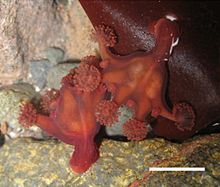Haliclystus antarcticus
| Haliclystus antarcticus | |
|---|---|
 |
|
| Scientific classification | |
| Kingdom: | Animalia |
| Phylum: | Cnidaria |
| Class: | Staurozoa |
| Order: | Stauromedusae |
| Family: | Lucernariidae |
| Genus: | Haliclystus |
| Species: | H. antarcticus |
| Binomial name | |
|
Haliclystus antarcticus Pfeffer, 1889 |
|
| Synonyms | |
|
Microhydrula limopsicola |
|
Microhydrula limopsicola
Haliclystus antarcticus is a stalked jellyfish which lives on rocky shore lines in the Southern hemisphere.
The original type specimens for this species have been lost. however the species was re-described in 2009. Individuals vary in colour from red-orange with light red gonads (individuals found at King George Island, Antarctica) to red and/or green (individuals found in Valdivia, Chile). Haliclystus antarcticus has a 'stalk' (peduncle) which is a half to two thirds the length of its calyx. The inside of the peduncle is divided into four chambers. The calyx itself is about 3.5–16.2 mm tall and 4.1–23.4 mm wide. It is cone shaped and semi-translucent with a smooth outer surface. The animal has eight arms arranged in pairs which radiate out from a central four sided mouth. The arms are 0.3–6.0 mm in length. Each arm is tipped by clusters of up to roughly 200 tentacles which are hollow and tipped with a rounded end covered in . The arms are connected by a thin membrane. Primary tentacles known as anchors are located on the membrane margin between the arms. The shape of these varies with age. In very young individuals (just after metamorphosis to medusae) they are circular, in juveniles they are triangular, in older organisms they are shaped like the figure '8' and have a longitudinal furrow and a wrinkled surface.
H. antarcticus is one of only two species of Haliclystus which inhabit the Southern hemisphere. It was first identified living in the waters of South Georgia Island, Antarctica. Its presence has since been reported in several locations in Antarctica with probable sightings in Chile and Argentina.
Scientists believe that as H. antarticus individuals grow they become too heavy for the algae to which they attach themselves in juvenile form. They then choose to relocate to another substrate where they are able to attach themselves more firmly. In a study of individuals in Chile sexually-immature individuals were found exclusively on Ceramium virgatum. Individuals which had reached sexual maturity were found on other substrates including marine eelgrass and other algae. In a study of individuals from South Georgia Island small animals were found on the macroalga Desmarestia menzie while larger animals were found on the underside of boulders.
...
Wikipedia
